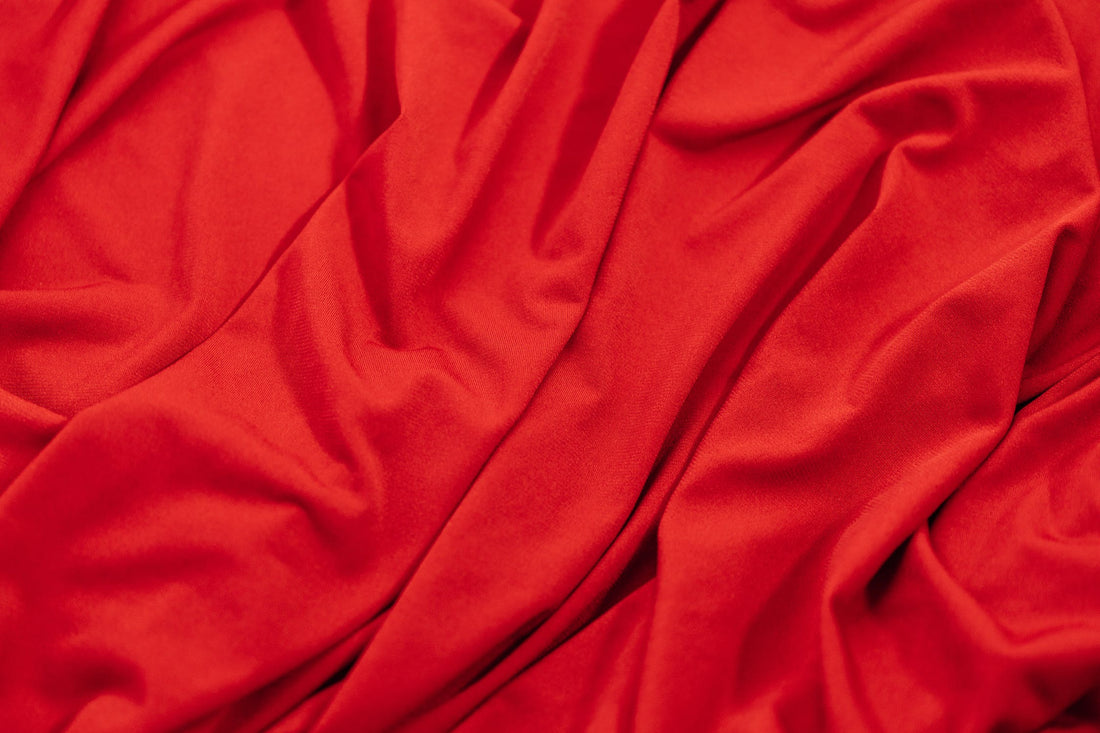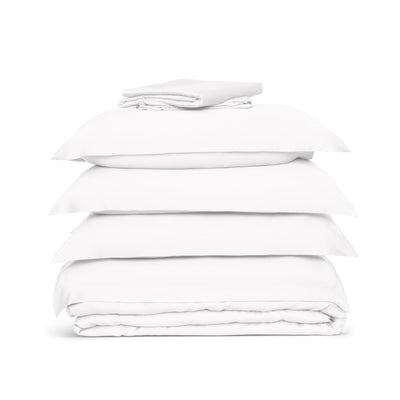Rayon can be a bit of a mystery for the average consumer. It is both old and new, natural and synthetic, ‘eco-friendly’ and toxic. Understandably, buyers often don’t know really what they’re getting with rayon products.
So, exactly what is rayon? We’ve provided a complete breakdown of the secrets of rayon to make shopping choices easier!
RAYON KEY QUESTIONS AND INFORMATION
- What is rayon fabric?
- Different types of rayon
- How is rayon made?
- Benefits of rayon
- Problems with rayon
- Is rayon sustainable?
WHAT IS RAYON FABRIC?
By definition, rayon describes textile fibres that have been regenerated from plant cellulose. The process was first developed in France in 1889 as part of an effort to recreate the luxury of silk with the benefit of more affordable prices. The resultant fabric was named viscose rayon.
Since the creation of viscose fabric, many more fabrics from different sources and with different manufacturing processes have been developed. Despite their differences, each is considered part of the rayon family.
Rayon is known as a semi-synthetic material. As the fabric is sourced from plant material, it is not considered fully synthetic. However, because of the regeneration process that requires many steps and additional chemicals, it cannot be classified as a natural fabric either.
One of the reasons for the confusion around rayon is that it is a label that can be used to describe multiple different fabrics that are used in the textile industry. We know that rayon fabric is made from regenerated plant cellulose, however, different fabrics can be made depending on both the plant that the fibres come from and the process through which it is regenerated.
DIFFERENT TYPES OF RAYON
Rayon fabric can be found everywhere, it is one of the most commonly used types of fabrics in existence. That’s because there are many different types of rayon that can be made cheaply to give different effects of cotton, silk and more.
The different types of rayon could be classified from the plant from which they are sourced. For example, some rayon fabrics are made from regenerated fibres from bamboo cellulose. Although this is different from genuine bamboo fabric, the bamboo label is a popular marketing tool.
Other sources of rayon include beech trees, pine trees, hemlock trees, cotton linters and even oranges.
More commonly, rayon fabrics are classified via the method with which they are prepared. Currently, there are three main categories of rayon preparation: viscose, modal and lyocell. Here is more detail about these sustainable fabrics:
What is Viscose?
Viscose is a type of rayon that is manufactured in a particular way. It is easily the most popular type of rayon and has been around the longest. It was first invented as a less expensive alternative to silk.
What is Modal?
Modal fabric is made from the cellulose of beech trees. It is slightly more flexible and able to withstand more wear than typical viscose rayon. It is also longer lasting and stronger, particularly when wet which allows for easier methods of cleaning and upkeep.
What is Lyocell?
Lyocell is not the same as its rayon cousins. Yes, it is made from the cellulose of wood pulp, but the manufacturing methods and chemicals used are hugely different. Lyocell is better known as the brand Tencel™ which is gaining popularity thanks to its high quality and environmental benefits. The process of manufacture is less wasteful and harmless chemicals are used.
HOW IS RAYON MADE?
Regardless of the material used, the processes to create rayon have many stages in common. This is because the manufacturing process is based on the key material cellulose. It is the cellulose from the natural material that first needs to be extracted and purified.
The cellulose is then treated with various toxic chemicals and put through a number of processes which will eventually turn it into a pulp.
The pulp is then pushed through small holes to create fibres which can then be spun into yarns and then spun into fabrics.
BENEFITS OF RAYON
Rayon’s value lies in its ability to imitate a range of luxury fabrics at a generally cheaper price. Viscose, the most common version of rayon, is able to imitate silk while other forms of rayon can give the effect of organic cotton or wool.
Thanks to the number of materials it can mimic, rayon has great versatility. It also drapes very well. Provides a luxurious feel and dyes easily. It therefore has a huge range of uses including clothing, furniture and bedding.
Fabrics in the rayon family have great breathability overall. They absorb moisture well and when used as bedding, they help to regulate temperature throughout the night and prevent sweating.
Although great overall, the breathability varies depending on which type of rayon fabric is used. Some, like viscose, are not quite as breathable as the silk it imitates. Although viscose is a great silk alternative, it is never quite as good as the real thing.
However, others, such as Lyocell or Tencel™, may be even more breathable than natural materials. Tencel has unmatched softness which, combined with its breathability, makes it the ideal choice for clothing and bedding.
PROBLEMS WITH RAYON
Unlike the silk it imitates, viscose rayon is not very strong or durable. It is easily damaged by light, moisture, heat and general wear and tear.
Viscose cannot be machine washed as it will be quickly misshapen through stretching or shrinkage of the fabric. Bedding or clothing made of viscose must be hand laundered and air dried, which can take up a lot of extra time.
Modal rayon is slightly stronger than viscose. It will last longer and can be machine washed, albeit at a cold temperature.
Lyocell, sold as Tencel™ is by far the strongest and most durable form of rayon. It is easy to care for, shrink resistant and will last a very long time. In the case of Tencel™, it is even stronger and more durable than organic cotton and silk!
IS RAYON SUSTAINABLE?
Again, the sustainability of rayon depends on the fabric. The two factors that determine whether a fabric is sustainable is the materials it is made from and the process by which it is made.
Regarding the original source of materials, every version of rayon has the potential to be sustainable as the cellulose comes from plants which is a renewable source. Unfortunately, this is not the case.
The overwhelming majority of plants grown for the production of viscose are not grown sustainably which has led to deforestation and major damage to local environments.
Modal is sourced from beech trees. Some brands that use modal fabrics have set up sustainable beech tree forests from which they get their materials. However, other manufacturers or vendors of modal are not as responsible and there are many modal products of the market with unsustainable sources.
As lyocell is one of the newer versions of rayon, the wood pulp required for the cellulose is more often sourced sustainably. To ensure ethical buying, it is best to stick to brands that guarantee that the wood is grown and harvested sustainably such as Tencel™.

Shop our Eucalyptus Tencel Bed Sheet Set
The manufacturing method is where most of the damage is done with regards to viscose. It requires a highly pollutive system that uses and wastes numerous toxic chemicals. These chemicals do great damage to not only the surrounding environment, but also to those working with them.
The manufacturing process of modal is less harmful to the environment than for viscose. Branded versions of modal in particular have made the effort to ensure that water use, and toxic chemicals are minimised.
Other methods of modal manufacture retain high water usage and toxic chemicals. Unfortunately, it is difficult for customers to know where their modal products are coming from.
Tencel™ is made using one of the most environmentally friendly production methods of all fabrics. It is created with organic solutions that not harmful to the environment. Additionally, it uses a closed loop system that minimises both water usage and waste.
Lyocell Tencel is not only the most eco-friendly material out of the rayon family, it is also one of the best overall. When choosing sustainable clothing and bedding, Tencel is a solid option for both luxury and sustainability.
















